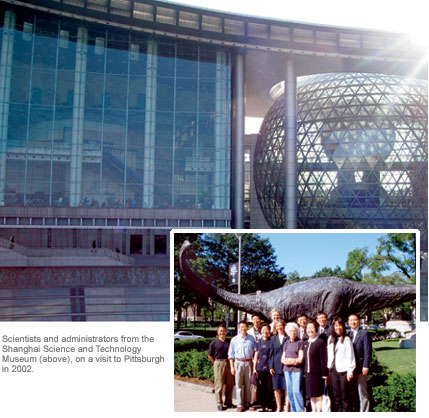Back

It started with a woman known for her bright personality,
a last name of (not surprisingly) Sun, and the nickname “Peachblossom.” It
originally involved six people and now involves millions.
What is this phenomenon? It’s the relationship between
Carnegie Museum of Natural History and the Shanghai Science
and Technology Museum (SSTM). And it’s only just
beginning.
Situated in the financial district of China’s
largest city, SSTM opened in 2001 in a multi-million-dollar
complex
the size of 13 football fields. It features two IMAX theaters,
six exhibition halls, and a natural history wing culled
from the older Shanghai Natural History Museum.
Known as
a “palace of science,” SSTM serves
China’s national plan to revitalize the country through
education and science. But after receiving massive crowds
during opening months, it has experienced a dip in attendance
and turned to other
museums for ideas.
Carnegie Museum of Natural History is
one such museum, attracting SSTM’s attention for
its renowned science, exhibitions, and education programs.
Responsible for the
initial contact was the museum’s library manager,
Xianghua “Peachblossom” Sun, who moved to Pittsburgh
in 1989 as part of an international scholars program that
connected museums around the world. Sun grew up in China
and worked for the Shanghai Museum of Natural History for
17 years.
“
Shanghai and Pittsburgh are the two places I call home,” says
Sun, who goes by the colorful nickname Peachblossom, a
title earned while eating lunch outside the museum one
sunny, spring day. “People appreciated my cheery
disposition, and the nickname stuck,” she explains. “I
even sign interoffice emails with the initials PB.”
When
Sun found out SSTM was seeking a partner with which to
exchange information, she convinced then-Deputy Director
Sylvia Keller to arrange a visit from six Shanghai representatives.
Arriving the summer of 2002, the group of scientists and
administrators
spent two weeks learning about the Museum of Natural History’s
mission and structure, while also getting a bird’s-eye-view
of its education programs. “They were full of questions
about how to build a successful natural history wing,” recalls
Sun, who served as a translator during the visit. “And
they learned from us that it takes more than an expensive
building and a lot of money; it takes years of research,
a strong collection, and focused audiences.”
The first
visit proved so fruitful that it set off a series of other
visits and laid the foundation for a long-term
relationship. The next exchange came the following year,
when Keller, Sun, Museum Director Bill DeWalt, and Chair
of Exhibits Jim Senior spent a week in Shanghai viewing
SSTM’s facilities and delivering formal presentations
about the Pittsburgh museum’s administrative structure
and educational programming. “They were particularly
impressed with our outreach programs to schools and the
community in general,” says DeWalt. “Like many
science museums, they face the challenge of attracting
repeat visitors because their exhibits rarely change. We
helped them realize how museum education programs can serve
the public and drive attendance.”
Between meetings,
DeWalt and his colleagues also toured Shanghai’s
older Natural History Museum, where Sun once worked. Despite
losing staff members and part of its
collection to SSTM, the museum remains open to the public.
“
Shanghai Natural History Museum is in poor condition,” laments
Sun. “We saw specimens in jars that were colorless,
exhibits that were outdated, and a huge shortage of people
staffing the facility.”
Opened in 1956 and located
in an older part of Shanghai, the Natural History Museum
looks unlike the modern museums
cropping up throughout the city. In an effort to update
the facility and become a world-class natural history museum—one
that surpasses the natural history wing of SSTM—scientists
and administrators are seeking government support for a
new building. They hope to equip it with state-of-the-art
exhibitions and programs in science and education.
“
The prospect of a new natural history museum in Shanghai
means a lot to us,” says DeWalt. “It could
open the door to more partnerships in science and collaborative
exhibitions.”
Until then, DeWalt explains, the collaboration
will stay focused on education, a high priority for both
SSTM and
Carnegie Museum of Natural History. A week-long visit in
October 2005 centered on this goal and involved Education
Chair Diane Gryzbek and Education Specialist Pat McShea,
who traveled to Shanghai by special invitation to provide
an overview of their division’s structure and financial
plan.
“
They wanted to know the nitty-gritty of how we run and
manage our programs,” says Grzybek. “We spent
an entire day talking about admission fees, rates for school
groups, endowments, donors, and relationships with corporations.”
Like
other government-sponsored cultural organizations in China,
SSTM wants to learn more about diversifying funding
sources and building programs that sustain themselves with
admission fees. This endeavor comes at a time of rapid
industrialization and financial growth in China, during
which the centrally-planned economy is starting to shift
to more of a market economy. Says Jin Xingbao, deputy director
of the Shanghai Museum: “The collaboration with Carnegie
Museum of Natural History helps us realize the crucial
role of education and how we can use it efficiently. Our
programs are a great marketing tool and an indispensable
part of our museum branding.”
To Sun, whose family
and friends still live in Shanghai, Jin’s words are
a dream come true. “The current
focus on education offers an invaluable service to my homeland,” she
says. “Few Chinese people attend university, but
many are hungry for knowledge. This is a perfect way to
satisfy their hunger.”
Back
| Top |